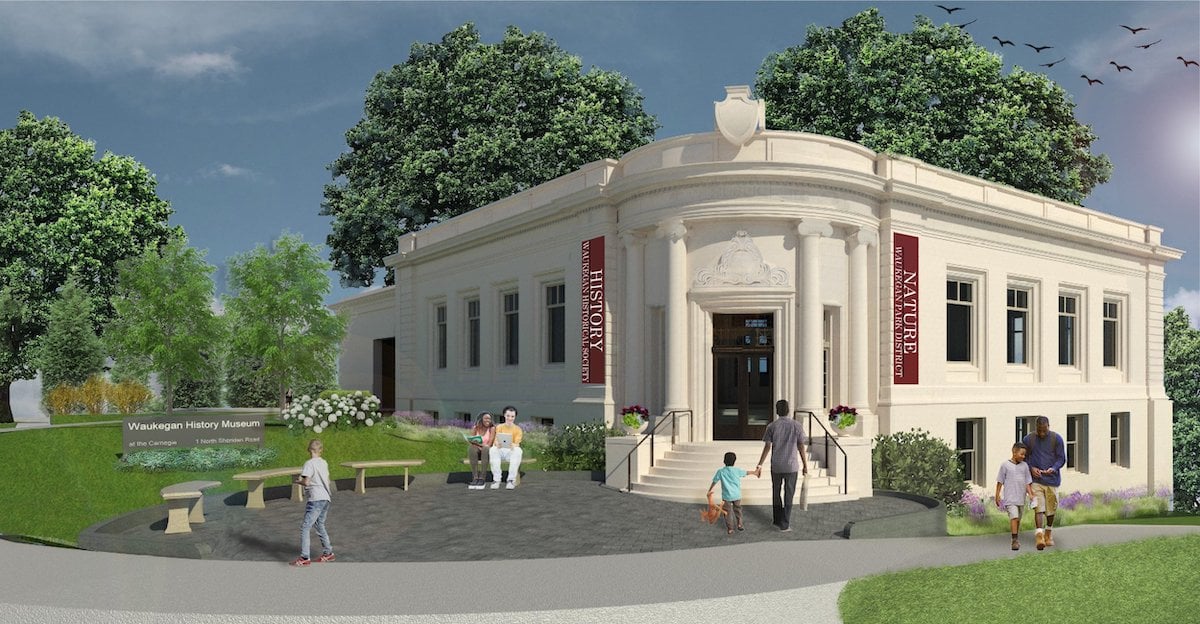Waukegan’s Museum Project Hints at Broader Revitalization
A long-vacant landmark in downtown Waukegan is coming back to life. The historic 1903 Carnegie Library is being transformed into the new Waukegan History Museum, a project set to open its doors this fall. Led by the Lake County Forest Preserve District and the Waukegan Historical Society, this restoration is more than a cultural investment; it’s a quiet signal of broader renewal in the city’s urban core.
While it may not generate headlines in the real estate trades, this project reflects something deeper: a slow but meaningful shift in how Waukegan is reimagining its built environment, one building at a time.

A Historic Anchor Returns
The Carnegie Library building, vacant since 1965, has long stood as a symbol of both Waukegan’s architectural past and its unrealized potential. Its thoughtful rehabilitation into a public museum isn’t just a win for preservationists—it marks a reinvestment in civic infrastructure at a time when many suburban cities are still grappling with downtown vacancies.
When cities breathe new life into heritage sites, it often signals a turning point. These anchors—cultural, architectural, and civic—have a magnetic effect. They attract pedestrians, elevate perceptions, and encourage new ideas for surrounding properties. For downtown Waukegan, this museum could play that role.
Real Estate Implications: Subtle, But Significant
For real estate investors and business owners, the museum project may be a sign worth watching.
1. A Boost in Foot Traffic and Visibility
The museum is poised to draw new visitors—locals, school groups, and cultural tourists alike. That added foot traffic can improve the viability of nearby storefronts, from coffee shops to galleries to professional offices. Retail spaces along Genesee Street and Washington Street may start to see the beginnings of renewed interest.
2. Public Sector Confidence
Waukegan’s investment in civic and cultural infrastructure suggests a willingness to support long-term placemaking. Often, projects like these precede broader initiatives, whether streetscape enhancements, zoning updates, or incentive programs. That kind of public-sector momentum provides a tailwind for commercial property owners looking to upgrade or reposition assets.
3. Adaptive Reuse Momentum
The successful transformation of the Carnegie building sets a quiet precedent. Waukegan has no shortage of older, underutilized buildings. This museum project could encourage other owners and developers to consider adaptive reuse or hybrid redevelopment, converting historic or vacant spaces into creative office, studio, or mixed-use formats.
Positioning Waukegan for Broader Appeal
While the Waukegan History Museum is not a megaproject, its timing and symbolism matter. In an era where smaller cities are seeking to redefine their identities, Waukegan is taking a measured but meaningful step toward becoming more than just a commuter hub.
Combined with assets like the Genesee Theatre, a walkable lakefront, and Metra service to Chicago, the addition of a revitalized cultural anchor helps reposition downtown Waukegan as a place of substance and identity. And for employers or entrepreneurs looking for a compelling, cost-effective location with a story to tell, that can be a real draw.
Looking Ahead
Markets don’t shift overnight. But they do shift. And often, the earliest signs are subtle: a long-empty building gets a second life. A museum opens. A few more people walk downtown. One lease gets signed, then another.
The Waukegan History Museum isn’t a solution to all of downtown’s challenges, but it’s a foundation to build on. And for those paying attention, tenants, owners, developers, and the commercial real estate agents who serve them, it’s a reminder that cities don’t need a boom to change course. Sometimes, they just need the right spark.

